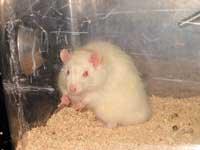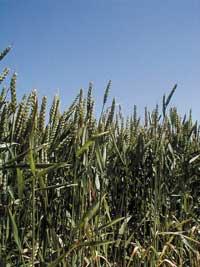Weapon to combat antipersonnel mines
2004/04/19 Atxotegi Alegria, Uhaina - Elhuyar Zientziaren Komunikazioa
The pain of people has been a good instrument during the war to kill the enemy, weaken it or not enter unwanted lands, and unfortunately it still exists. Although some countries have tried to prohibit or restrict the production of this weapon, there are still many sewn lands of this type of mines. Therefore, several researchers have addressed the detection of antipersonnel mines.
The number of people who kill antipersonnel mines every year is terrible. With the aim of somehow dealing with this problem, lately there have been numerous methods.
Saving plants
At the end of January, the Danish biotech company Aresa Biodetection reported that from an evil herb and using bioengineering techniques, it created a plant capable of detecting unexploded pain.
According to researchers, green leaves become red when the plant absorbs nitrogen dioxide from the mines. The plant used by Danish researchers is called Arabidopsis thaliana. Small leaf, its flowers are not spectacular. And how do you change color? The absorption of nitrogen dioxide by plant roots results in a biochemical process that accelerates the production of natural anthocyanin pigment. This natural pigment extends to the entire plant, so that the leaves are golden.
This plant has several advantages for researchers. The first and most important is that its genome was decoded many years ago. In addition, it grows rapidly and, except at the poles, can grow anywhere without taking care of itself. Finally, it should be noted that this is a hard plant, that is, it is not necessary to cut down painful areas for the planting of this plant. But the existence of such a hard plant has the danger of proliferating too much and damaging local vegetation. To avoid this, scientists have sterilized male plants.
The Danes have done all their tests in greenhouses, but in view of the results, Bosnia, Sri Lanka or some African countries will begin the tests.
Plants that change color and shape
A team of American researchers, led by Canadian molecular biology professor Michael Deyholos, has created genetically modified plants to detect buried antipersonnel mines.
The idea was carried out by Anthony Faust, a researcher from the Canadian Department of Defense. In fact, when he was watching on television a report of revegetation of Mars, he discovered that some of the methods that appeared on it serve to detect antipersonnel mines. Most of this type of underground weapons are made up of trinitrotolos (TNT) and other chemical components that, over time, are dispersed through the ground. Therefore, Canadian scientists will introduce genetically modified plants in these lands whose roots will change color or shape when detecting TNT. In this way, they will know where exactly the pains are.
Rats with good odor
In addition to Europe and the United States, anti-pain campaigns are being organized in Africa. At the agricultural university of Sokoine (Tanzania) they have found a new, economical, agile and fast tool to help deal with this problem in some way. Local scientists use rats to detect mines. These animals are formed to smell mines and explosives. They say they are more effective than dogs, since they serve several owners.
These rats are given a harness connected to a mobile lane while working. This harness is placed on a metal grid. Two researchers leave the grid on the ground and begin to move until the rat ole something. In the rat's nasal immersion area, they are usually in pain. The animal, as it could not be otherwise, receives a prize (usually a piece of banana) every time it finds a pain.
These rats measure about 75 cm and weigh about 1.35 kg. In dangerous terrain they can circulate freely without any pain, as they are too light to pop. This method of rats has been used in Mozambique. As a result of the civil war, there are still 500,000 mines against people who have not been exploited.
All these methods of detecting antipersonnel mines represent another step in the fight against this type of weapons. However, what is clear is that these devices must be inactivated by a person. The risk, therefore, has not completely disappeared and it must be borne in mind that some states continue to produce mines.
Origin of the mines
The origin of the term pain is based on an old military technique. Mines were formerly used to vibrate the walls of the enemy's fortresses. When gunpowder was invented, they began to fill the tip of the mines with this dust and make it explode. This method was widely extended during the Renaissance and even more so during World War I.
The risk of these devices was considerable, which caused anti-cart pains. However, they also caused numerous casualties and eventually invented anti-personnel mines. These types of pain have evolved over the years and today they use cutting-edge technologies to create increasingly sophisticated pains.
The main headache of mining entrepreneurs is the use of materials that do not detect these devices, especially to be effective, that is, to kill as many people as possible. Antipersonnel mines with metallic components were produced over the years, but when detected with some ease by the rivals, materials such as plastic or wood were used.
There are currently more than 340 mine models. The price increases or decreases depending on the technological advances of each. The simplest cost is 1.5 euros, but the average price of pressurized mines is 4.8 euros. The so-called "elegant" mines, with self-regulatory mechanisms, cost 181 euros.
Painful consequences
According to the International Committee of the Red Cross, the mines cause 800 deaths per month (26 per day). The U.S. government claims that mines cause 26,000 deaths each year. However, it is very difficult to know the exact number of people affected, since the walled villages do not have sufficient infrastructure to do so.
In addition, if you analyze the economic consequences, the plague of pain affects your economy. And it is necessary to take into account that health care must be provided to people who are injured with pain and that these expenses are normally borne by the State. These victims need a large amount of blood and, in addition to special surgical interventions, some are given prostheses. Then they have to be rehabilitated. The average cost per patient is 360 euros. Moreover, people who could work until then become a social burden, not only for their families, but for the whole people.
On the other hand, the mere underground mines affect the lands. And of course, with the explosion the damage increases even more. Trees and plants suffer the expansive wave, causing them great damage. Therefore, pains also greatly alter the ecological environment.
On the other hand, the deactivation of an anti-personnel mine costs between 210-720 euros, according to the United Nations. Costs therefore skyrocket.
Numerous attempts have been made to detect these devices, which remain numerous researchers. Although all these advances serve to save one life, we could say they are effective. But will the problem ever be solved or terminated?
We could say that there are two types of researchers: on the one hand, those who, at the technological level, invent increasingly sophisticated mines against people and, on the other, those who work to detect and deactivate those ailments. But who pays all of them?
An endless battle
To end the battle of anti-personnel mines, several peoples signed the Ottawa treaty in 1997. Under this treatment, signatories are prohibited from using, storing, producing and transporting mines. Currently, 150 countries have signed and renewed the Ottawa Treaty, but 44 countries are missing, including the United States, Cuba, Russia, China, etc.
Even if it seems a lie, between 5 and 10 million mines per year are still produced in the private and public companies of these 44 municipalities. During the Cold War, the main suppliers were Czechoslovakia, Italy, Yugoslavia and the Soviet Union. Currently, Pakistan, Egypt, Italy and South Africa have great strength in this market. However, it is enough that there is a single producer and buyer of anti-personnel mines to make this battle endless.
Mining models and manufacturers
Published in D2 section of Deia.

Gai honi buruzko eduki gehiago
Elhuyarrek garatutako teknologia





